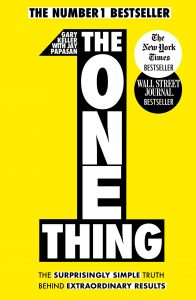
1.The One Thing:
- According to the author, there is only one question that needs to be asked to figure out your long-term and short-term priorities- “What’s the ONE thing I can do, such that by doing it everything else will become easier or unnecessary?”
- The best shot at success at anything is by narrowing your focus on that ONE thing the most.
2. Create A Domino Effect:
- The secret sauce for extraordinary results is to create a domino effect in your life. Success will happen over time. It is built in a sequential manner and also compounds with time. Slowly but surely.
The author tackles a few conceptions/myths regarding success:
1. All things matter equally:
- When everything feels important and urgent, we develop a sense of being active and busy. But in hindsight, this doesn’t take us anywhere near to success.
- Learn to develop a clear sense of priority.
- Create a Success list that will contain purposeful goals with the aim to deliver extraordinary results. Until you go from many to critical few, to the essential ONE.
2. Multitasking:
- One of the most common myths is that multitasking is the same as productivity.
- Truth is, doing two things at once results in doing half work or even worse no good work.
- Doing two things at once is possible, but doing two things effectively at once is not.
- Avoid multitasking at all cost when performing important tasks.
3. A Disciplined Life:
- A very different perspective that is not so commonly caught on to. But in reality, according to the author, you don’t need to have a lot of discipline to become successful.
- The reason behind this that success is actually about doing the right thing, not about doing everything right.
- And that’s the trick to success- to pick the right things and fuel them with enough discipline to properly establish them.
- The key is to develop the right habits and the important things more regularly.
4. Willpower Is Always On-Demand:
- Do not commit yourself to willpower for success without understanding it.
- Using your mind throughout the day will significantly reduce your mental capacity and willpower. You cannot suddenly create it. It takes patience and practice to slowly develop it.
- The author suggests doing the important thing, the ONE thing first before you burn your willpower.
5. Living A Balanced Life:
- No matter how hard you try, at the end of the day, there will always be things left unfinished and unattended. That’s just the reality of life.
- Trying vigorously to get all things done may actually be more detrimental in achieving productivity than doing all the right and important things.
- The key is to understand that leaving some things undone is a critical and necessary trade-off for achieving exceptional results.
- Pick what matters the most, and give it all.
6. Big Is Bad:
- You can never estimate or set a limit to the potential that can be achieved.
- Don’t put a cap on believing in big, else you might miss out on many great opportunities and risk settling for less.
# Key Takeaways:
– The key to success is focusing on one thing at a time, rather than trying to multitask.
– Prioritizing and eliminating distractions is crucial in achieving your goals.
– The 80/20 rule, also known as the Pareto Principle, states that 20% of your efforts will lead to 80% of your results.
– Time blocking, or dedicating specific chunks of time to your most important tasks, can greatly increase productivity.
– Continuously asking yourself “What’s the one thing I can do right now that will make everything else easier or unnecessary?” can help guide your actions and decisions.
# Practical Application:
– Identify your ultimate goal and break it down into smaller, achievable tasks.
– Use the 80/20 rule to prioritize your tasks and focus on the most important ones.
– Eliminate distractions and create a conducive environment for productivity.
– Use time blocking to dedicate specific chunks of time to your most important tasks.
– Continuously ask yourself the focusing question to guide your actions and decisions.
# Valuable Insights for Leaders and Managers:
– Chapter 3: “The Truth About Time Management” emphasizes the importance of prioritization and time blocking for leaders and managers.
– Chapter 4: “The Path to Great Answers” discusses the power of asking the right questions and how it can lead to better decision-making.
– Chapter 6: “The Success Habit” delves into the importance of forming habits and how they can lead to long-term success.
– Chapter 9: “The Three Commitments” highlights the importance of accountability and staying committed to your goals.
# Case Studies and Examples:
– The story of Gary Keller and his journey to success serves as a real-life example of the principles outlined in the book.
– The “Focusing Question” is illustrated through various case studies, such as the success of Domino’s Pizza and the downfall of Blockbuster.
– The concept of time blocking is demonstrated through the story of Bill Gates and his approach to managing his time effectively.
Leave a Reply